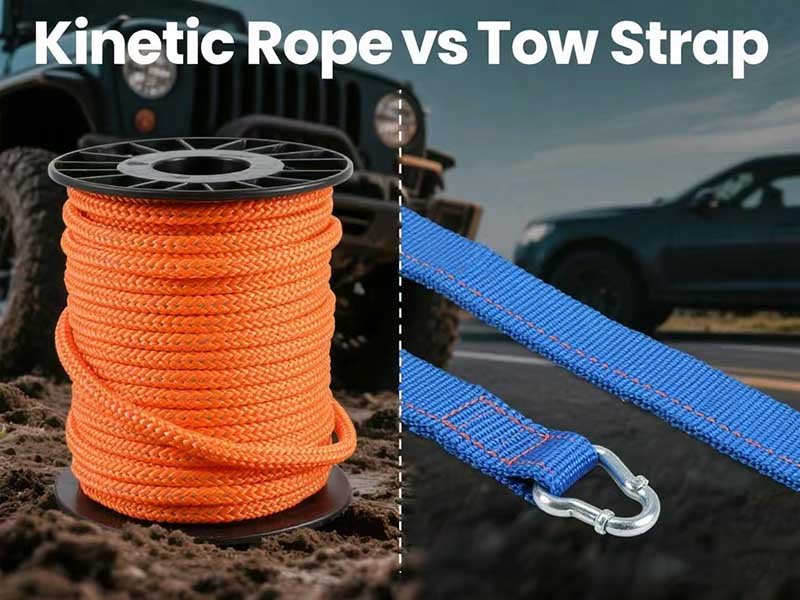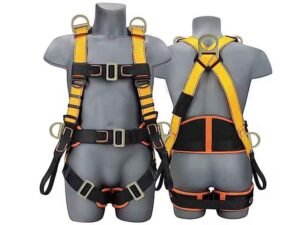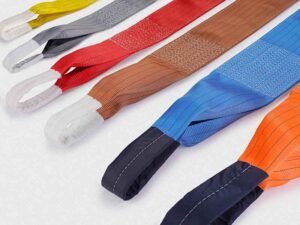When your vehicle is stuck in mud, snow, or a ditch, the right recovery tool can mean the difference between frustration and freedom. In the world of vehicle recovery—especially off-road adventures or emergency roadside rescues—kinetic ropes and tow straps are two of the most commonly used solutions. But which one truly works best? That depends on how and where you’re using them.
Kinetic ropes are ideal for off-road recovery due to their stretch and energy absorption, while tow straps are better suited for slow, controlled towing on paved surfaces. Each serves a specific purpose, and using the wrong one could be dangerous.
More than just gear, these tools are part of your safety system. Misusing a tow strap during a snatch recovery, or relying on a kinetic rope for flat towing, could damage your vehicle—or worse. That’s why knowing the difference matters, especially if you’re a buyer looking to customize or source straps for a brand, a retail line, or recovery gear inventory.
So, let’s break it down. First, we’ll explain exactly what each tool is and how they function. Then, we’ll dive deeper into real-world comparisons, materials, applications, and finally, where you can get high-quality OEM recovery straps directly from experienced manufacturers like Szoneier.
What Are Kinetic Ropes and Tow Straps Used For in Recovery?
Kinetic ropes are used to recover stuck vehicles using momentum and stretch, while tow straps are designed for steady towing over flat ground. They serve different purposes and are made from different materials.
What Is a Kinetic Rope?
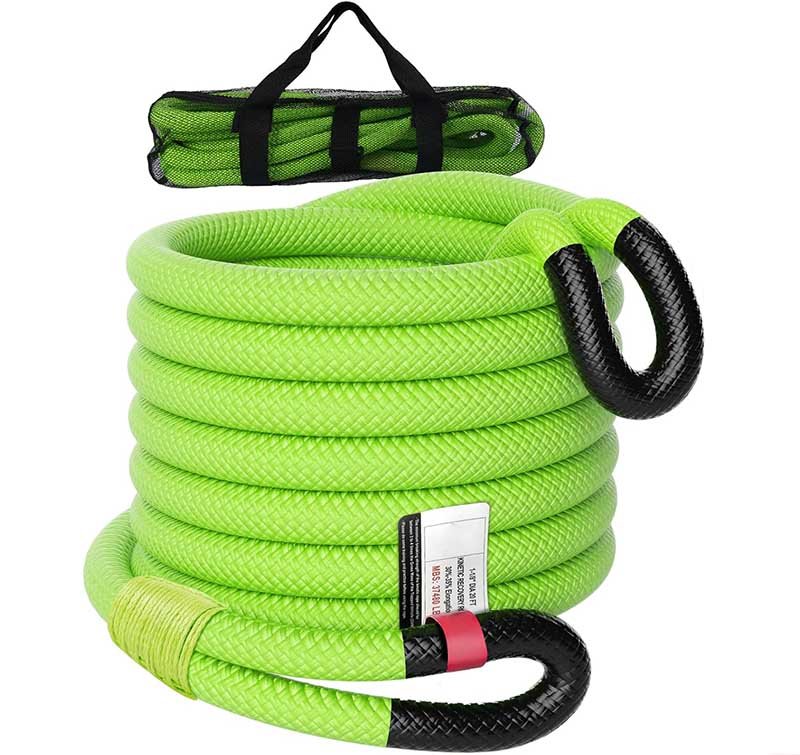
A kinetic rope is a high-stretch nylon recovery rope designed to pull vehicles out of tough spots by using kinetic energy. Instead of tugging with direct force, the rope stretches and snaps back, creating momentum that helps “yank” the vehicle free. It’s commonly used in off-road recovery where vehicles are stuck in mud, sand, or snow.
Key features include:
- Material: Usually 100% nylon
- Elasticity: Up to 30% stretch
- Use case: Snatch recovery in off-road scenarios
- Strength rating: Often rated 2-3x the weight of the vehicle
The elasticity not only reduces the jolt during recovery but also minimizes stress on both vehicles. It’s safer and more forgiving than a rigid strap.
What Is a Tow Strap?

A tow strap is a non-elastic, flat webbing strap used for pulling or towing a free-rolling vehicle. Made from polyester or polypropylene, it offers little to no stretch, which makes it better for controlled, continuous pulls rather than shock loads.
Typical characteristics:
- Material: Polyester or PP (low-stretch)
- Elasticity: Less than 10%
- Use case: Towing non-stuck vehicles on paved roads
- Design: Often comes with reinforced loops or metal hooks
Tow straps are best used when a vehicle just needs to be pulled a distance (e.g., from a breakdown spot to a garage), not when it’s bogged down.
What Is the Difference Between Kinetic and Tow Rope?
| Feature | Kinetic Rope | Tow Strap |
|---|---|---|
| Material | Nylon | Polyester or Polypropylene |
| Stretch Factor | Up to 30% | Less than 10% |
| Best Use | Off-road vehicle recovery | On-road vehicle towing |
| Recovery Type | Snatch or momentum recovery | Steady pull, no momentum |
| Safety Level | Absorbs shock, safer for frame | More jolt, higher tension spikes |
| Durability | Very high with protective ends | High but more prone to sudden tear if overloaded |
Kinetic ropes are dynamic and designed to stretch and rebound, while tow straps are static and meant for controlled, non-shock loads. Each has its role, but confusing them can cause equipment failure or vehicle damage.
Which Is Stronger: Kinetic Rope or Tow Strap?

Kinetic ropes are designed to absorb shock and have high breaking strength, while tow straps offer static pulling strength. Strength depends on material, width, and construction.
When comparing which is stronger—kinetic rope or tow strap—the answer isn’t as simple as just measuring the tensile force. Strength needs to be defined in two ways:
- Working Load Limit (WLL) — The maximum force a strap can consistently handle during regular use.
- Breaking Strength (BS) — The maximum load the strap can bear before it fails.
Let’s break it down:
- Kinetic ropes, made from nylon, are designed to stretch up to 30%, which not only absorbs shock but also dramatically reduces stress on anchor points. Many 7/8″ (22mm) kinetic ropes have a breaking strength of 28,000 lbs (12,700 kg) or more. That makes them incredibly strong for off-road recoveries.
- Tow straps, made from polyester or polypropylene, don’t stretch much. A typical 2″ wide polyester tow strap can have a breaking strength of 20,000–30,000 lbs, depending on weave and stitching. However, it lacks the dynamic shock absorption that kinetic ropes provide, which can lead to snapping or sudden failure under jerking forces.
Practical Example:
| Strap Type | Width | Material | Breaking Strength | Stretch |
|---|---|---|---|---|
| Kinetic Rope | 7/8″ | Nylon | 28,000 lbs | 30% |
| Tow Strap | 2″ | Polyester | 20,000–30,000 lbs | <10% |
| Tow Strap | 3″ | Polypropylene | 25,000 lbs | ~10% |
In practical terms, a kinetic rope may feel weaker because it stretches, but it’s actually engineered to sustain energy. A tow strap may appear sturdier due to its rigidity, but it’s more vulnerable to shock load failures, especially if misused in snatch recoveries.
How Do Kinetic Ropes Work in Off-Road Recovery?
Kinetic ropes use momentum and stretch to safely and effectively recover stuck vehicles, especially in off-road environments like mud or sand.
The physics behind a kinetic rope are both simple and brilliant. When a recovery vehicle pulls away from a stuck one using a kinetic rope, the rope stretches like a rubber band. That stretch stores energy (kinetic energy), which is then released as the rope contracts, delivering smooth, controlled pulling force—not a jolt.
This method is highly effective in off-road situations where tires are buried or traction is minimal. The dynamic recovery avoids sudden jerks, reducing the risk of vehicle damage or injuries.
Key Advantages of Kinetic Ropes in Off-Road Scenarios:
- Smooth Load Transfer: No metal-to-metal shock, reducing risk of breaking recovery points.
- Efficient Energy Use: Converts towing motion into snatch force without hard contact.
- Safety: Minimizes stress on hooks, bumpers, frames, and passengers.
- High Performance in Slippery Terrain: Mud, snow, and sand all benefit from kinetic recovery.
Use Case:
A 4×4 Jeep stuck in deep mud attempts to self-recover but fails. Another Jeep uses a kinetic rope with 20 feet of length. After a short acceleration, the rope stretches and snaps back, giving the stuck Jeep just enough momentum to break the suction of the mud and roll free—without any damage to either vehicle.
In contrast, if this were done with a tow strap, the sudden tension might result in frame damage, hook breakage, or injury.
When Should You Use a Tow Strap Instead of a Kinetic Rope?
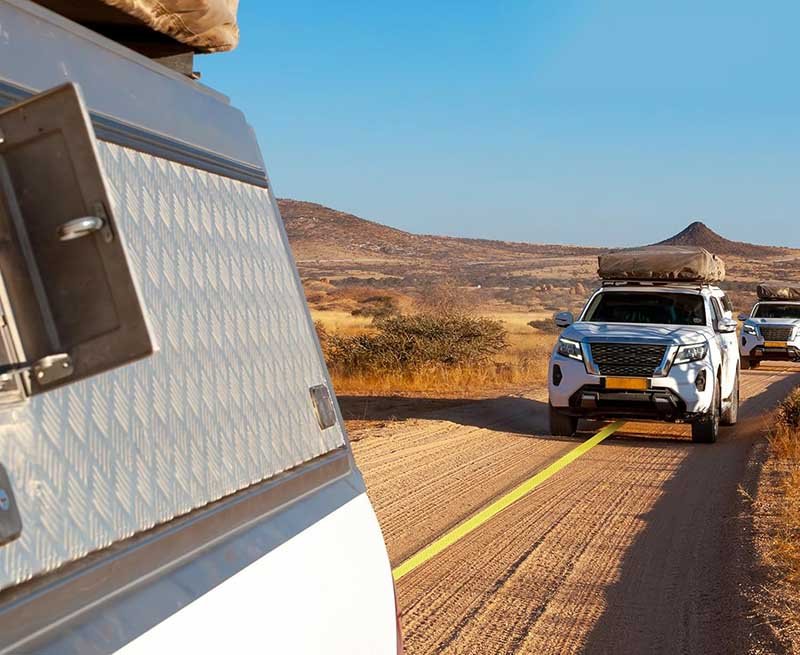
Use a tow strap when towing a free-rolling vehicle over a paved surface or short distance where stretch is unnecessary and control is the priority.
Not every recovery situation calls for dynamic force. In many cases—like pulling a stalled car out of a parking spot, or towing a dead car to a mechanic—a tow strap is the better choice. Its rigidity offers direct, predictable pulling power.
Tow straps are ideal when:
- The vehicle is not stuck, just disabled
- You’re operating in urban or paved environments
- You need a controlled, slow pull
- You’re not using a running start
Trying to use a kinetic rope in this case would result in a spring-like bounce, making the process harder to manage and potentially unsafe.
Additionally, tow straps often include hooks or shackles, making them more convenient for quick setups. However, this also introduces more failure points, so always check hardware strength.
Tow straps are also easier to store, often cheaper, and available in different widths and strengths—making them ideal for emergency kits in passenger vehicles.
Is Kinetic Rope Safer Than a Tow Strap?
Kinetic ropes are generally safer for off-road recovery due to their ability to absorb energy and reduce shock loads, minimizing vehicle and user risk.
Safety in vehicle recovery is crucial—and often underestimated. The question isn’t whether a rope or strap will move a vehicle, but how safely it will do so. Here’s where kinetic ropes truly shine.
Kinetic ropes are made with military-grade nylon, designed to stretch and rebound under extreme tension. This makes them safer for frame-mounted recovery points, unlike tow straps which may cause frame damage or hook snapping due to their lack of elasticity.
Real-World Safety Comparison:
| Factor | Kinetic Rope | Tow Strap |
|---|---|---|
| Shock Absorption | Excellent | Poor |
| Injury Risk if Breaks | Lower (less snapback) | Higher (rigid recoil) |
| Force Distribution | Smooth, progressive pull | Immediate, concentrated pull |
| Hook Hardware Requirement | Often loop ends | Often metal hooks = failure risk |
Using a tow strap for a dynamic recovery is dangerous. When a tow strap breaks under pressure, the recoil can turn a metal hook into a projectile, causing injury or damage. This is why kinetic ropes are highly recommended by off-road professionals and safety organizations.
However, safety also depends on proper usage. Misusing a kinetic rope—like connecting it to weak tow points—can also be dangerous. Always pair it with rated shackles, soft shackles, and anchor points.
How to Choose the Right Recovery Strap for Your Vehicle?
Choose your recovery strap based on your vehicle’s weight, terrain type, and recovery style. Material, width, and stretch are key decision factors.
The best strap is the one that matches your recovery scenario. Here’s how you can make an informed choice:
Based on Vehicle Weight and Usage
You should select a recovery rope or strap with a breaking strength 2-3 times the weight of your vehicle.
| Vehicle Type | Recommended Strap Type | Minimum Breaking Strength |
|---|---|---|
| Compact Car | Tow Strap | 10,000 lbs |
| SUV / Pickup | Kinetic Rope | 20,000–28,000 lbs |
| Off-Road 4×4 | Kinetic Rope | 28,000–35,000 lbs |
| Heavy Truck | Extra-wide Tow Strap | 30,000–40,000 lbs |
Comparing Nylon, Polyester, and Polypropylene Webbing
| Material | Use Case | Properties |
|---|---|---|
| Nylon | Kinetic rope | High stretch, durable, absorbs shock |
| Polyester | Tow strap | Low stretch, high tensile strength |
| Polypropylene | Light-duty tow strap | Low cost, UV resistant, less durable |
Custom Branding and OEM Options from Manufacturers
If you’re a buyer or distributor, consider customizing:
- Color and length
- Private label logo printing
- Reflective strips for visibility
- Reinforced loops or protective sleeves
- Branded packaging for retail
Szoneier provides all these customizations under low MOQ, with quick sampling and fast lead times.
Do You Need Both a Kinetic Rope and a Tow Strap?
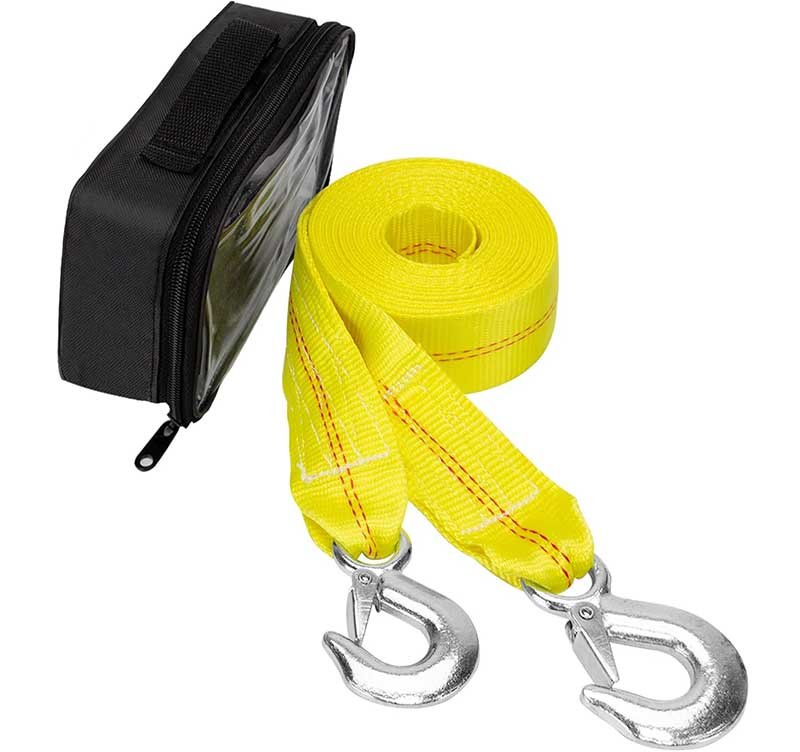
For full recovery readiness, having both a kinetic rope and tow strap ensures you’re covered for both off-road recovery and roadside towing.
Professionals and off-road enthusiasts typically carry both tools. Why?
- Kinetic rope handles snatch recoveries
- Tow strap handles flat towing
- Both tools together mean preparedness for any recovery scenario
For buyers, selling them as a combo kit makes great commercial sense.
Where to Buy High-Quality Custom Tow Straps and Kinetic Ropes?
Szoneier offers OEM and private label recovery straps with premium materials, fast delivery, and low MOQs for global buyers.
If you’re looking for trusted, quality recovery products, Szoneier is your go-to webbing and strap manufacturer in China. With 18+ years of experience, we specialize in:
- Nylon, polyester, and cotton webbing manufacturing
- Custom recovery straps, loops, and rope ends
- OEM, private label, and branded solutions
- Low MOQ and fast prototyping
- Global delivery and certification support
Whether you’re a brand building a rugged outdoor line, or a distributor supplying auto shops and recovery teams, we’re equipped to deliver durable, customized solutions at scale.

